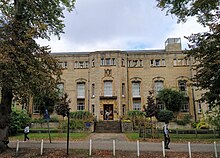Department of Plant Sciences, University of Oxford
The Department of Plant Sciences, at the University of Oxford, England, was a former Oxford department that researched plant and fungal biology. It was part of the university's Mathematical, Physical and Life Sciences Division. From 1 August 2022 its functionality merged with the Department of Zoology to become the Department of Biology at the University of Oxford.[1]
 The Department of Biology, South Parks Road, which was formerly known as the Department of Plant Sciences. | |
| Merged into | Department of Zoology |
|---|---|
| Successor | Department of Biology |
| Formation | 1621 |
| Dissolved | 2022 |
| Website | www |
Herbaria
editThe department housed the Oxford University Herbaria that consists of two herbaria:[2]
- Fielding-Druce Herbarium.
- Daubeny Herbarium.
In total the collections contain 800,000 specimens[3] and benefits from close links with the university's Oxford Botanic Garden. The herbaria are now housed under the title of Department of Biology.
History
editForestry was an important part of the university under the name of the Imperial Forestry Institute, from 1924;[4][5] later the Commonwealth Forestry Institute from 1939.[6] The Oxford Forestry Institute was incorporated into the Department of Plant Sciences in 2002,[7] and research relating to forestry was undertaken under that name until 2022 when the department merged with the Department of Zoology to form the Department of Biology.[1] Some students were Imperial Forest Service students, who came from many parts of the British Empire to qualify as foresters before they returned home.[8] It ran a post graduate MSc forestry course for many years: Forestry and its Relation to Land Use,[9] until 2002.[7]
In January 2021, the Oxford City Council approved the £200m construction of the Life and Mind Building,[10] which will be the university's largest building project and combine the Departments of Experimental Psychology and Biology.[11] It will replace the Tinbergen Building on South Parks Road, which was closed and demolished when asbestos was discovered in 2017.[12] The building will feature multiple laboratories, teaching and testing spaces providing research facilities for 800 students and 1200 researchers. Work is expected to start in June 2021, with the building opening in September 2024.[12]
See also
editReferences
edit- ^ a b "Oxford launches new department to further bioscience teaching and research | University of Oxford". ox.ac.uk. August 2022. Retrieved 15 August 2022.
- ^ Bloom, Michael. "26 November 2015 – Oxford University Herbarium". abnats.org.uk. Retrieved 6 September 2017.
- ^ "Oxford Plant Systematics". Herbaria.plants.ox.ac.uk. Retrieved 26 August 2015.
- ^ "Imperial Forestry Institute, Oxford". Nature. 137 (3466): 573. 1936. Bibcode:1936Natur.137Q.573.. doi:10.1038/137573a0.
- ^ "The Imperial Forestry Institute, Oxford". Nature. 139 (3522): 731–732. 1937. Bibcode:1937Natur.139..731.. doi:10.1038/139731a0.
- ^ The History of the University of Oxford. Trevor Henry Aston, J. I. Catto, T. A. Ralph Evans, James McConica, Nicholas Tyacke, Lucy Stuart Sutherland, Leslie George Mitchell, Michael G. Brock, Mark C. Curthoys and Brian Howard Harrison. Oxford University Press, 1984. ISBN 0-19-822974-7, ISBN 978-0-19-822974-2
- ^ a b Burley, Jeffery; Mills, Roger A; Plumptre, Robert A; Savill, Peter S; Wood, Peter J; Wright, Howard L (March 2009). "Witness to History A History of Forestry at Oxford University". British Scholar. I (2): 236–61. doi:10.3366/brs.2009.0007. Retrieved 29 December 2017.
- ^ Excerpta e statutis universitatis Oxoniensis: titulus XIV, de vestitu et habitu scholastico; titulus XV, de moribus conformandis; titulus XXIII, of women students. Oxonii: e Prelo Clarendoniano, [1925], pp. 374-75
- ^ [1] Archived 3 July 2007 at the Wayback Machine
- ^ "The Life and Mind Building". lifeandmind.web.ox.ac.uk.
- ^ Lowe2021-01-21T06:00:00+00:00, Tom. "Wates gets planning green light for Oxford uni's biggest ever project". Building. Retrieved 10 February 2021.
{{cite web}}: CS1 maint: numeric names: authors list (link) - ^ a b "University of Oxford's £200m life sciences building plan approved". BBC News. 21 January 2021. Retrieved 10 February 2021.